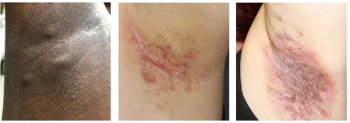
- Dermatology Times, November 2022 (Vol. 43. No. 11)
- Volume 43
- Issue 11
Exploring What’s Possible for HS Treatment
At the 2022 Fall Clinical Dermatology Conference, Joslyn R. Sciacca Kirby, MD, MS, MEd, and Raj Chovatiya, MD, PhD, discussed how there is a large unmet need for hidradenitis suppurativa treatment and what future treatment could look like.
Hidradenitis suppurative (HS) is a rare, chronic inflammatory disease that affects many patients' physical and mental well-being. Joslyn R. Sciacca Kirby, MD, MS, MEd, associate professor of dermatology at Penn State Health in Hershey, Pennsylvania, and Raj Chovatiya, Md, PhD, assistant professor of dermatology at the Northwestern University Feinberg School of Medicine and director of the Center for Eczema and Itchy at Northwestern University in Chicago, Illinois, presented “Getting Inflamed About HS: Exploring What’s Possible,” at the 2022 Fall Clinical Dermatology Conference in Las Vegas, Nevada.1
Kirby began the session by giving an overview of awareness for HS and patient statistics. Patients with HS wait approximately 7 years until they are given an HS diagnosis. Typically, patients have HS for 1-3 years before they even seek out a provider. This is often due to embarrassment of the disease, or patients think they have somehow caused their HS due to not using the right soaps or needing to change their towels more often. Lack of awareness among the medical community is another reason patients with HS do not receive a diagnosis for such a long period of time.
“Part of this delay in diagnosis comes from a lack of awareness among our colleagues in medicine, whether that’s emergency departments, primary care physicians, or even gynecologists,” said Kirby.
Another challenge in HS treatment is the use of biologics. Dermatologists have become more comfortable using biologics for other dermatologic conditions such as psoriasis and atopic dermatitis. But there is a hesitancy to use biologics for HS. Kirby states that once patients with HS are in severe stages, it’s hard to expect biologics to make a significant difference. Only 6% of patients with HS are on biologics. Additionally, 37% of patients find it very difficult to access dermatologists.
HS is a debilitating disease because it affects both mental and physical well-being. Pain is the most burdensome symptom, according to patients with HS. The inflammation, boils, and cysts are painful on an everyday basis. Similarly, painful cysts can cause difficulty with relationships and sexual activity. Substance abuse and suicidal ideations are also very common among patients with HS due to the impaired quality of life.
“One of the ways that we are trying to improve the situation is we need the help of all of our colleagues outside of dermatology to help us get people diagnosed,” said Kirby.
Chovatiya began his portion of the presentation by discussing what’s going on therapeutically with HS diagnosis and treatment. Currently, there is only one non-surgical treatment approved for HS, adalimumab, which targets TNFα.
“Based on some of the insights we’ve learned from other inflammatory diseases like Chron’s disease, there may be a window of opportunity where we could hit [HS] early in a targeted fashion and prevent this late disease that makes it so difficult when we manage these [HS] patients that are in later stages,” said Chovatiya.
Chovatiya believes that treatment options for HS are less ambitious than treatment goals in other dermatologic conditions. For example, major strides have been in psoriasis to achieve 90%-100% clearance, while in HS, the primary endpoint that has been extensively studied is the Hidradenitis Suppurativa Clinical Response score of only 50% improvement.
“We obviously have work to do there. Our endpoints are maybe not as lofty as they need to be, but we’re not even doing a great job of keeping people at that [50%] point and continuously under control on the drug itself,” said Chovatiya.
Reference
- Sciacca Kirby J, Chovatiya R. Getting inflamed about HS: Exploring what’s possible. Fall Clinical 2022. October 21, 2022. Las Vegas, Nevada.
Articles in this issue
about 3 years ago
New Tech for Skinabout 3 years ago
Update on New Laser Treatments for Acneabout 3 years ago
Are You Prepared for Potential Tax Law Changes?about 3 years ago
Genetic Profiling and the Future of Therapeutics in Dermatologyabout 3 years ago
Low-Dose Oral Minoxidil for Hair Growthabout 3 years ago
The Role of Precision Medicine in the Management of Melanomaabout 3 years ago
The Latest Buzz in Atopic Dermatitisabout 3 years ago
Hand Healthabout 3 years ago
Hidradenitis Suppurativa: Current and Future TreatmentsNewsletter
Like what you’re reading? Subscribe to Dermatology Times for weekly updates on therapies, innovations, and real-world practice tips.


















